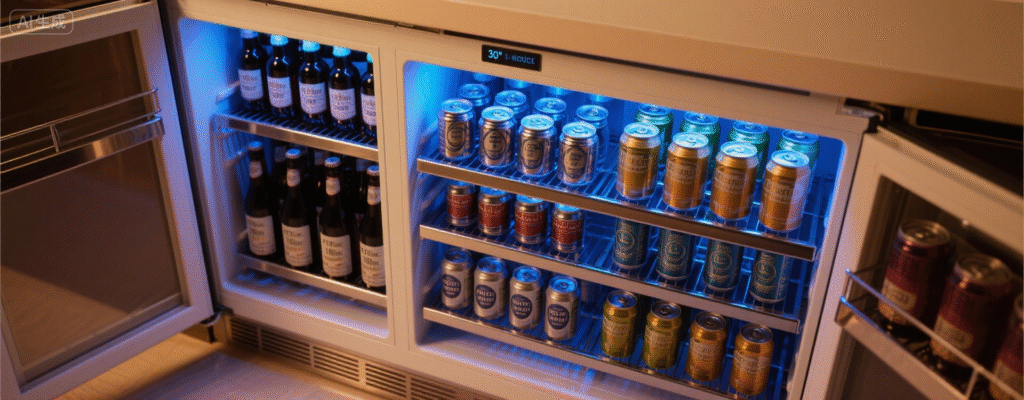How Much Space Do You Need for a 30-Inch Built-In Beverage Fridge?
Planning a kitchen remodel or bar upgrade and considering a built-in beverage center? Understanding the precise space requirements for a 30-inch built-in beverage fridge is crucial for a seamless installation. Unlike freestanding units, built-in models require specific cabinet cutouts and ventilation clearances to function correctly and efficiently. This guide will walk you through the essential dimensions, from the standard cutout size to the critical front venting clearance needed for models like the Tittla 30 Dual-Zone refrigerator. Getting these measurements right the first time prevents costly delays and ensures your new appliance integrates perfectly into your cabinetry.
Width, Height, and Depth Standards
The nominal “30-inch” label refers to the cabinet opening width, not the unit’s exterior dimensions. For a proper fit, you must account for the exact cutout specifications provided by the manufacturer.
Standard Cutout Dimensions
- Cutout Width: Typically 30 inches exactly. The unit’s actual width is often slightly less (e.g., 29.5 inches) to allow for a snug fit within the opening.
- Cutout Height: Standard built-in height is 34.5 inches. This allows the unit to fit under a standard countertop with an integrated toe kick.
- Cutout Depth: A minimum of 24 inches is standard, ensuring the unit sits flush with or slightly proud of the cabinet face.
Always defer to the manufacturer’s specific installation manual. For example, the installation guide for the Tittla 30 specifies the exact 30-inch beverage fridge cutout size required for a perfect fit.
Ventilation Path and Clearance Requirements
Proper ventilation is non-negotiable for the longevity and efficiency of your beverage center. Built-in units dissipate heat through a front-venting system, which requires specific clearances around the grill or vent area.
Front Venting Clearance
- A minimum of 1-2 inches of clearance is typically required at the front grille to allow for adequate airflow.
- Never block the vent with cabinetry, decorative panels, or other obstructions.
- For models with a Low-E anti-condensation glass door, like the Tittla, ensuring proper ventilation also helps manage humidity and prevent condensation buildup.
Adhering to the specified built-in beverage center clearance prevents the compressor from overworking, which can lead to premature failure and increased energy consumption, as outlined in performance data from ASHRAE standards for refrigeration systems.
Electrical and Water Line Considerations
Most built-in beverage refrigerators do not require a water line for operation, simplifying their installation compared to icemaker-equipped refrigerators.
Electrical Requirements
- Requires a standard 115V, 15-amp dedicated outlet.
- The outlet should be easily accessible, ideally in an adjacent cabinet, to allow for service and potential disconnection.
- Ensure the electrical code in your area is followed, particularly for installations in damp locations like a wet bar.
Floor Leveling and Shim Usage
An often-overlooked aspect of installation is ensuring the unit is perfectly level. An unlevel refrigerator can lead to door seal issues, improper cooling, and noisy operation.
Leveling Procedure
- Use a carpenter’s level to check the floor of the cabinet cutout both side-to-side and front-to-back.
- If the floor is uneven, use plastic shims to create a perfectly level base before sliding the unit into place.
- Many units have adjustable front legs for fine-tuning the level after installation.
A level installation is key to the advertised quiet operation, as an unbalanced compressor can generate excessive vibration and noise.
Common Builder and DIY Mistakes to Avoid
Even experienced installers can make errors when fitting a built-in appliance. Being aware of these common pitfalls can save time and money.
Top Installation Errors
- Ignoring Ventilation Clearance: The most frequent mistake is failing to leave the required space for front ventilation, leading to overheating.
- Assuming Exact Fit: Ordering cabinetry with a 30-inch opening without verifying the manufacturer’s specific cutout dimensions can result in a unit that is too tight or too loose.
- Forgetting the Dedicated Circuit: Plugging a beverage center into an already loaded circuit can cause tripped breakers.
- Neglecting to Level: Assuming the floor is level and skipping this step can compromise door seals and cooling performance.
Frequently Asked Questions
Can I install a built-in beverage fridge in a cabinet without a front vent?
No. All built-in refrigeration units require a ventilation path to expel heat. Front-venting models are designed to work without side or top clearance, but the front grille must never be obstructed.
What is the difference between a built-in and an integrated beverage center?
A “built-in” model is designed to fit within a cabinet cutout and has a finished exterior, often with its own door. An “integrated” model is designed to accept a custom cabinet panel on the front, so it disappears completely into the cabinetry.
How much weight can a standard kitchen cabinet hold for a built-in beverage fridge?
A fully loaded 30-inch beverage cooler can weigh over 150 pounds. Standard kitchen base cabinets are structurally designed to support countertops and heavy appliances, but it’s always prudent to confirm with your cabinet manufacturer or builder.
Does a dual-zone beverage fridge require more clearance than a single-zone model?
Not typically. The ventilation and cutout requirements are based on the refrigeration system’s physical size and heat output, not the number of zones. Always follow the specific model’s installation guide.
Can I use a beverage fridge as a drawer in a kitchen island?
While possible, it requires specialized cabinetry and careful planning for ventilation and access. It’s a complex installation best handled by a professional. For inspiration, explore our guide on kitchen island beverage center ideas.
Ready to integrate a high-capacity, dual-zone cooler into your home? The Tittla 30-inch beverage refrigerator combines a spacious interior for 29 bottles and 88 cans with the sleek, integrated look you desire. For more detailed technical guidance, don’t forget to consult our comprehensive beverage fridge cutout dimensions guide.
